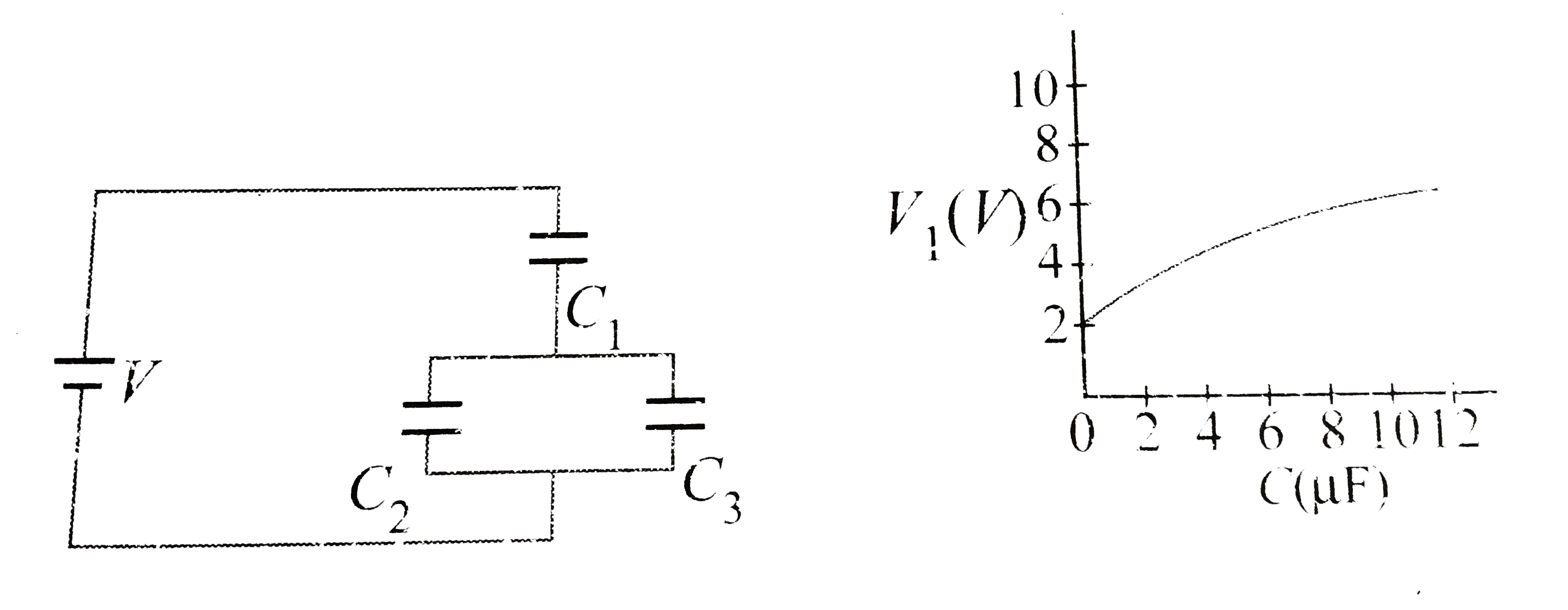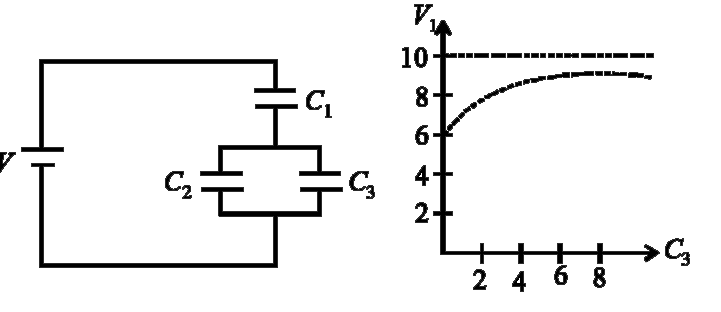Capacitor C3 in the circuit is a variable capacitor (its capacitance can be varied). C1andC2 are of fixed values. Graph is plotted between potential difference V1 (across capacitor C1) versus C3. Electric potential V1 approches on asymptote of 10 V as C3∝∞.
 ,
,
When V1=4Vm then C3 is equal to
5C2/2
5C1/3
5C2/3
none of these
The correct Answer is:D
When C3→∞ it means distance between the plates of C3 is zero or both plates will be at the same potential then C2 will be shorted entire pontential V will ber across C1 hence V=V1=10V
From graphs when C3=0,V1=2V.SoC3 will act like open switch C1 and C2 will be in series potential different across C2 is V2=10−V1
=8V
q=C1V1=C2V2 or C12=C28 or C1=4C2
V1=4V,V2=10−4=6V
q=C1V1=(C2+C3)V2
or C14=(C2+C3)6 or 16C2=6C2+6C3
or C3=5C2/3
Topper's Solved these Questions
- MISCELLANEOUS VOLUME 3Book:CENGAGE PHYSICSChapter:MISCELLANEOUS VOLUME 3Exercise:Interger Answer type
Explore 20 Videos
- MISCELLANEOUS VOLUME 3Book:CENGAGE PHYSICSChapter:MISCELLANEOUS VOLUME 3Exercise:Fill in the blanks
Explore 10 Videos
- MISCELLANEOUS VOLUME 3Book:CENGAGE PHYSICSChapter:MISCELLANEOUS VOLUME 3Exercise:Assertion and Reason Type
Explore 8 Videos
- MECHANICAL PROPERTIES OF SOLIDSBook:CENGAGE PHYSICSChapter:MECHANICAL PROPERTIES OF SOLIDSExercise:Question Bank
Explore 4 Videos
- MISCELLANEOUS VOLUME 5Book:CENGAGE PHYSICSChapter:MISCELLANEOUS VOLUME 5Exercise:Integer
Explore 12 Videos
Similar Questions
Capacitor C3 in the circuit is variable capacitor (its capacitance can be varied). Graph is plotted between potential difference V1 (across capacitor C1) versus C3.
Electric potential V1 approaches on asymptote of 10 volts as C3→∞
The ratio of the capacitance C1C2 will be
View SolutionCapacitor C3 in the circuit is variable capacitor (its capacitance can be varied). Graph is plotted between potential difference V1 (across capacitor C1) versus C3.
Electric potential V1 approaches on asymptote of 10 volts as C3→∞
0The value of C3 for which potential difference across C1 will become 8V, is
View Solution
Knowledge Check
Capacitor C3 in the circuit is a variable capacitor (its capacitance can be varied). C1andC2 are of fixed values. Graph is plotted between potential difference V1 (across capacitor C1) versus C3. Electric potential V1 approches on asymptote of 10 V as C3∝∞.
 ,
,
Relation between C1andC2 isAC1=C2BC1=4C2C4C1=C2Dany relationCapacitor C3 in the circuit is a variable capacitor (its capacitance can be varied). C1andC2 are of fixed values. Graph is plotted between potential difference V1 (across capacitor C1) versus C3. Electric potential V1 approches on asymptote of 10 V as C3∝∞.
 ,
,
The electric potential V across the battery is equal toA10VB12VC16VD20VCapacitor C3 in the circuit is a veriable capacitor (its capacitance can be varied). Group is plotted between potential difference V1 (across capacitor C1) versus C3. Electric potential V1 approaches to 10 V as C3→∞. Given that C1+C2=10μF

EMF of the battery is equal toA10 VB12 VC16 VD20 V
Capacitor C3 in the circuit is variable capacitor (its capacitance can be varied). Graph is plotted between potential difference V1 (across capacitor C1) versus C3.
Electric potential V1 approaches on asymptote of 10 volts as C3→∞
The ratio of energy stored in capacitorC1 to that of total energy whenC3→∞ is
View SolutionCapacitor 3 in Fig. 25-40a is a variable capacitor (its capacitance C3 can be varied) Figure 25-40b gives the electric potential V1 across capacitor 1 versus C3 The horizontal scale is set by C3s=12.0μF Electric potential V1 approaches as asymptote of 8.0 V as C3→∞ What are (a) the electric potential V across the battery , (b) C1 and (c) C2?

View SolutionCapacitor C3 in the circuit is a veriable capacitor (its capacitance can be varied). Group is plotted between potential difference V1 (across capacitor C1) versus C3. Electric potential V1 approaches to 10 V as C3→∞. Given that C1+C2=10μF

The capacitance of the capacitor C1 value
View SolutionTwo capacitors C1 and C2 are connected in a circuit as shown in figure. The potential difference (VA−VB) is

View SolutionTwo capacitances of capacity C1and C2 are connected in series and potential difference V is applied across it. Then the potential difference across C1 will be
View Solution

